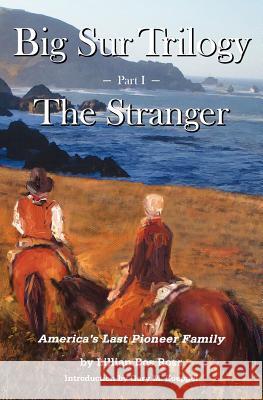Big Sur Trilogy: Part I - The Stranger: America's Last Pioneer Family » książka
Big Sur Trilogy: Part I - The Stranger: America's Last Pioneer Family
ISBN-13: 9781938924002 / Angielski / Miękka / 2012 / 278 str.
Big Sur Trilogy: Part I - The Stranger: America's Last Pioneer Family
ISBN-13: 9781938924002 / Angielski / Miękka / 2012 / 278 str.
(netto: 70,17 VAT: 5%)
Najniższa cena z 30 dni: 68,41 zł
ok. 13-18 dni roboczych.
Darmowa dostawa!
The Big Sur Trilogy is the story about one of the last pioneer families in America who lived freely and self-sufficiently in a remote area of the central California known as Big Sur. The Trilogy spans over 100 years and depicts the hard but rewarding life of three generations of the Zande Allan family. The Big Sur Coast extends 100 miles from Carmel to San Simeon and is bordered by the Santa Lucia Mountains and Pacific Ocean. This remote wilderness contains some of the most rugged terrain in the American continent. From the beginning of time the south coast was accessible only by foot, mule or horseback. Although inhabited by three nomadic American Indian tribes, the Spaniards refused to travel along the coast because of the high mountains, steep canyons and dangerous water crossings. In the 1870s a partial wagon road was built from Mal Paso Crossing to Bixby Creek Ranch. The next 74 miles of the Big Sur Coast was not accessible by auto until 1937 with the opening of Highway One, which took eighteen years to build, mostly by convict labor using dynamite and steam shovels. When completed, it became the only road in the United States that went directly from a horse trail to an auto road, thus bypassing the traditional, interim wagon road. The road changed forever the lives of the Big Sur homesteaders as the mainstream modern American culture motored into their once-private coast. Before the road, few 'outlanders' visited the south coast because travel was strenuous, the trail precarious and the homesteads were few and far between, but those who ventured there were greeted with coast hospitality, lively conversation and ranch grown food. The Big Sur pioneer families worked long hours and full days with little time for frills or fancy things, and they had no patience for what was not plain spoken. A trip to Monterey to buy supplies or to Salinas to sell cattle took three hard days by horseback along narrow trails at the edge of granite cliffs often falling straight to the sea some 2000 feet below. Twice a year the ranchers would gather for a coast barbecue with neighbors on the beach while waiting for the cargo schooner to arrive and winch ashore their load of hard stock supplies too bulky for pack mule or horse. The Stranger, the first of the three novels, begins in 1870 as Zande Allen arrives on horseback at the stage in Monterey to meet Hannah, his mail order bride who came from the east by rail and stage to marry and live with him on his cattle ranch on the remote south coast. At thirty years old, Zande had worked hard to build up a small cattle ranch, but none of the coast women suited him and he needed a wife to help with the chores and bear him children. Hannah, a refined Swedish lady from the Midwest who had never wed, was surprised to discover the man she had come so far to marry was abrupt, hard spoken and ignorant about women, while Zande was immediately suspicious of her every word and thought her too refined, too weak and soft to learn the ways of coast women. Known as a strong man on the coast, he was not about to be bested by any woman, especially by one he bought and owned. After an explosive wedding night, they began a long period of estrangement as both tried to understand each other's strange ways. In addition to being nettled by trying to figure out his new wife, Zande had many misadventures, including his brief tryst with Maria Dumas, a Spanish coast girl who had been chasing him for years; his near-death battle with a nine-foot grizzly bear; and his capture of a gang of cattle rustlers, for which he received an unexpected reward. Still perplexed by his new wife, he took a steamer to San Francisco where he spent his reward money and bought things to surprise her upon his return---things he never believed he would ever buy or be able to afford. Zande and his bride finally make peace and, in the end, he declares, "For the first time in my life I feel to home in world I was borned in."











